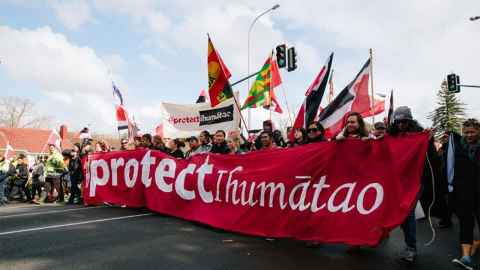Much to learn from the ahi kaa of Ihumātao
2 October 2019
Opinion: The ahi kaa of Ihumātao have much to teach our nation and its visitors through their manaakitanga and stories, explains Frances Hancock and Tim McCreanor.

Public remarks by some politicians and media commentators, either hampered by ignorance or motivated by mischief, have sown seeds of confusion about the status of the contested land at Ihumātao near Auckland Airport.
Fletcher Building, which owns the land, has plans to build 480 dwellings (Special Housing Area 62), but tens of thousands of New Zealanders have expressed strong opposition to housing development on this historic site.
Some politicians argue that Crown intervention will disrupt decades of Treaty negotiations and threaten “full and final” settlements that have been concluded. This argument rests on an assumption that the system works perfectly well, should not be disrupted and needs no improvements. It is scaremongering that fuels ill-informed commentary and inflames Pākehā fear.
The fact is the contested land at Ihumātao has never been part of any Treaty settlement and its 1863 confiscation has never been addressed.
Fletcher’s suggestion that one iwi, Te Kawerau A Maki, has paramount status in this area is specious and wrong, and should prompt us all to ask what business a transnational corporation thinks it has presuming to decide iwi status. Te Kawerau A Maki does not yet have its own marae, so that iwi signed its deed of settlement (which settles their tuupuna whenua in Waitakere) at Makaurau Marae in Ihumātao. It was a venue only. Te Kawerau A Maki is a completely different iwi from the mana whenua opposing the development, who are of Te Ahiwaru and Ngaati Mahuta whakapapa of Makaurau Marae.
As a result of Fletcher’s false assertion about the status of Te Kawerau A Maki, the ahi kaa – the home people of Makaurau Marae in the Ihumātao Village most affected by the proposed development – have been excluded from decision-making. The active engagement of the ahi kaa in the process now being facilitated by the Kingitanga begins to address this injustice.
Contrary to reports, the ahi kaa have never been willing to settle, since they know it would mean their extinction. Without their lands they do not exist and Ihumātao is the last remnant of confiscated whenua available for return.
Other commentators have rightly pointed out that the much-publicised mana whenua entanglements in this situation are not about an internal iwi struggle that pits rangatahi against kaumatua, but rather about who has the longest continuous occupation, the deepest commitment to the whenua. The issue is, which group is exercising kaitiakitanga by seeking the protection of this nationally important taonga – a unique cultural heritage landscape – for future generations?
The problem of Special Housing Area 62 is moral, ethical and political in nature, and can be addressed outside of Treaty settlements to alleviate concerns over disrupting existing settlements.
Contrary to reports, the ahi kaa have never been willing to settle, since they know it would mean their extinction. Without their lands they do not exist and Ihumātao is the last remnant of confiscated whenua available for return.
The SOUL Campaign seeking to stop the Fletcher development has presented to Government and Auckland Council a list of precedents that can guide responsible decision-making. Progress may include other parties, such as philanthropic funders who, in this case, may want to support a peaceful settlement that all parties can live with. The special heritage character of this area and its significance to our nation’s history demand no less.
What is needed is a creative, innovative and elegant solution. SOUL said this in their original submission to Parliament in February 2016. It’s time the Government and Auckland Council did the right thing, the just thing, without further delay.
Since July 23, we have witnessed the ahi ka being present on the whenua with enormous dignity, strength, courage and conviction – women, men, and children of all ages, acting in a peaceful, positive, productive and highly organised manner. They have endured the worst winter weather and suffered the most frustrating inconveniences, with seemingly inexhaustible aroha and humour. Their daily routine begins and ends with karakia. Sunday is a day of thanksgiving or whakamoemiti, and people of diverse faiths and cultures join them. That kind of human witness has a godly character and challenges us to pay attention and listen to them.
Every day now this highly contested whenua demonstrates an enormous healing capacity – through its timeless beauty, its rare cultural heritage, and the extraordinarily warm, gracious, humble welcome – which Māori call manaakitanga – of the home people, the ahi kaa.
This whenua brings together broad diversities of peoples, touches their hearts, gently informs their minds and most importantly enables them to be together.
In a world where people so frequently go to war over difference, we desperately need places and spaces like Ihumātao to remind us that we are all human, that our shared humanity matters, and our diversity is our strength.
The ahi kaa of Ihumātao have so much to teach our nation and its visitors through their manaakitanga and their stories. They tell us they will stay with this struggle for justice until the end. So will their supporters. But a question remains: How long must those on the frontline brave the wild wet weather and sleep in tents?
Dr Frances Hancock is an honorary academic at Te Puna Wānanga, The School of Maori and Indigenous Education, in the Faculty of Education. Professor Tim McCreanor is a social scientist at Massey University. Both are supporters of the SOUL Campaign.
This article reflects the opinion of the authors and not necessarily the views of the University of Auckland.
Used with permission from Newsroom Much to learn from the ahi kaa of Ihumātao 2 October 2019.
Media queries
Alison Sims | Research Communications Editor
DDI 09 923 4953
Mob 021 249 0089
Email alison.sims@auckland.ac.nz